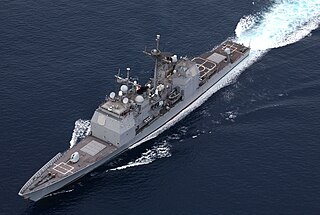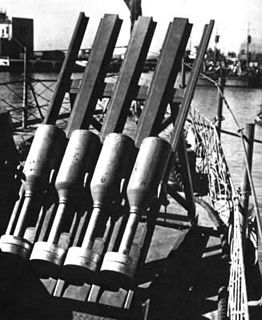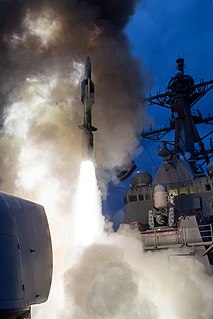 W
WThe Aegis Ballistic Missile Defense System is a United States Department of Defense Missile Defense Agency program developed to provide missile defense against short to intermediate-range ballistic missiles. It is part of the United States national missile defense strategy. Aegis BMD is designed to intercept ballistic missiles post-boost phase and prior to reentry.
 W
WThe Aegis Combat System is an American integrated naval weapons system developed by the Missile and Surface Radar Division of RCA, and now produced by Lockheed Martin. It uses powerful computer and radar technology to track and guide weapons to destroy enemy targets.
 W
WThe Mark 143 Armored Box Launcher (ABL) is a four-round protected launch container for the BGM-109 Tomahawk Cruise Missile.
 W
WThe ASM-N-8 Corvus was an anti-radiation missile developed by Temco Aircraft for the United States Navy.
 W
WA depth charge is an anti-submarine warfare (ASW) weapon. It is intended to destroy a submarine by being dropped into the water nearby and detonating, subjecting the target to a powerful and destructive hydraulic shock. Most depth charges use high explosive charges and a fuze set to detonate the charge, typically at a specific depth. Depth charges can be dropped by ships, patrol aircraft, and helicopters.
 W
WThe Hedgehog was a forward-throwing anti-submarine weapon that was used primarily during the Second World War. The device, which was developed by the Royal Navy, fired up to 24 spigot mortars ahead of a ship when attacking a U-boat. It was deployed on convoy escort warships such as destroyers and corvettes to supplement the depth charges.
 W
WThe Iowa-class battleships are the most heavily armed gunships the United States Navy has ever put to sea, due to the continual development of their onboard weaponry. The first Iowa-class ship was laid down in June 1940; in their World War II configuration, each of the Iowa-class battleships had a main battery of 16-inch (406 mm) guns that could hit targets nearly 20 statute miles (32 km) away with a variety of artillery shells designed for anti-ship or bombardment work. The secondary battery of 5-inch (127 mm) guns could hit targets nearly 9 statute miles (14 km) away with solid projectiles or proximity fuzed shells, and was effective in an anti-aircraft role as well. Each of the four battleships carried a wide array of 20 mm and 40 mm anti-aircraft guns for defense against enemy aircraft.
 W
WA magnetic anomaly detector (MAD) is an instrument used to detect minute variations in the Earth's magnetic field. The term refers specifically to magnetometers used by military forces to detect submarines ; military MAD equipment is a descendant of geomagnetic survey or aeromagnetic survey instruments used to search for minerals by detecting their disturbance of the normal earth-field.
 W
WThe Mark 11 guided missile launching system (GMLS) is a twin-arm missile launcher designed for use on frigates and other military vessels.
 W
WThe Mark 13 guided missile launching system (GMLS) is a single-arm missile launcher designed for use on frigates and other military vessels. Because of its distinctive single-armed design, the Mark 13 is often referred to as the "one-armed bandit."
 W
WThe Mark 26 Guided Missile Launching System (GMLS) was a United States Navy fully automated system that stows, handles, and launches a variety of missiles. The system supported RIM-66 Standard, RUR-5 ASROC, and potentially other weapons. The Mark 26 had the shortest reaction time and the fastest firing rate of any comparable dual arm shipboard launching system at the time. With only one man at the control console, a weapon can be selected, hoisted to the guide arm, and launched. Several mods provided magazine capabilities of 24 to 64 missiles.
 W
WThe Tartar Guided Missile Fire Control System is an air defense system developed by the United States Navy to defend warships from air attack. Since its introduction the system has been improved and sold to several United States allies.
 W
WThe Mark 92 Fire Control System is a US-built medium-range anti-aircraft missile and gun fire control system. It was developed for the FFG-7 Oliver Hazard Perry class guided missile frigates. The system is a licensed USN version of the Thales Nederland WM-25 fire control system. The Mark 92 fire control system was approved for service use in 1975. Introduction to the fleet and follow-on test and evaluation began in 1978.
 W
WMousetrap was an anti-submarine rocket used mainly during the Second World War by the U.S. Navy and the U.S. Coast Guard. Its development began in 1941 as a replacement for Hedgehog, a British-made projector, which was the first forward-throwing ASW weapon. Those, however, were spigot-launched, placing considerable strain on the launching vessel's deck, whereas Mousetrap was rocket-propelled. As a result, Mousetrap's four or eight rails for 7.2-inch (183 mm) rockets saved weight and were easier to install.
 W
WA naval mine is a self-contained explosive device placed in water to damage or destroy surface ships or submarines. Unlike depth charges, mines are deposited and left to wait until they are triggered by the approach of, or contact with, any vessel. Naval mines can be used offensively, to hamper enemy shipping movements or lock vessels into a harbour; or defensively, to protect friendly vessels and create "safe" zones. Mines allow the minelaying force commander to concentrate warships or defensive assets in mine-free areas giving the adversary three choices: undertake an expensive and time-consuming minesweeping effort, accept the casualties of challenging the minefield, or use the unmined waters where the greatest concentration of enemy firepower will be encountered.
 W
WNew Threat Upgrade (NTU) was a United States Navy program to improve and modernize the capability of existing cruisers and destroyers equipped with Terrier and Tartar anti-aircraft systems, keeping them in service longer. It was a key component of then-President Ronald Reagan's 600-ship Navy plan.
 W
WOperation Bumblebee was a US Navy effort to develop surface to air missiles (SAMs) to provide a mid-range layer of anti-aircraft defence, between anti-aircraft guns in the short range and fighter aircraft operating at long range. A major reason for the Bumblebee efforts was the need to attack bombers before they could launch standoff anti-shipping weapons, as these aircraft might never enter the range of the shipboard guns.
 W
WThe Convair RIM-2 Terrier was a two-stage medium-range naval surface-to-air missile (SAM), and was among the earliest surface-to-air missiles to equip United States Navy ships. It underwent significant upgrades while in service, starting with a beam-riding system with 10-nautical-mile (19 km) range at a speed of Mach 1.8, and ending as a semi-active radar homing system with a range of 40 nmi (74 km) at speeds as high as Mach 3. It was replaced in service by the RIM-67 Standard ER (SM-1ER).
 W
WThe Bendix RIM-8 Talos was a long-range naval surface-to-air missile, and was among the earliest surface-to-air missiles to equip United States Navy ships. The Talos used radar beam riding for guidance to the vicinity of its target, and semiactive radar homing (SARH) for terminal guidance. The array of four antenna which surround the nose are SARH receivers which functioned as a continuous wave interferometer. Initial thrust was provided by a solid rocket booster for launch and a Bendix ramjet for flight to the target with the warhead serving as the ramjet's compressor.
 W
WThe General Dynamics RIM-24 Tartar was a medium-range naval surface-to-air missile (SAM), and was among the earliest surface-to-air missiles to equip United States Navy ships. The Tartar was the third of the so-called "3 T's", the three primary SAMs the Navy fielded in the 1960s and 1970s, the others being the RIM-2 Terrier and RIM-8 Talos.
 W
WThe RIM-67 Standard ER (SM-1ER/SM-2ER) is an extended range surface-to-air missile (SAM) and anti ship missile originally developed for the United States Navy (USN). The RIM-67 was developed as a replacement for the RIM-8 Talos, a 1950s system deployed on a variety of USN ships, and eventually replaced the RIM-2 Terrier as well, since it was of a similar size and fitted existing Terrier launchers and magazines. The RIM-66 Standard MR was essentially the same missile without the booster stage, designed to replace the RIM-24 Tartar. The RIM-66/67 series thus became the US Navy's universal SAM system, hence the "Standard Missile" moniker.
 W
WThe RIM-174 Standard Extended Range Active Missile (ERAM), or Standard Missile 6 (SM-6) is a missile in current production for the United States Navy. It was designed for extended range anti-air warfare (ER-AAW) purposes providing capability against fixed and rotary-wing aircraft, unmanned aerial vehicles, anti-ship cruise missiles in flight, both over sea and land, and terminal ballistic missile defense. It can also be used as a high speed anti-ship missile. The missile uses the airframe of the earlier SM-2ER Block IV (RIM-156A) missile, adding the active radar homing seeker from the AIM-120C AMRAAM in place of the semi-active seeker of the previous design. This will improve the capability of the Standard missile against highly agile targets, and targets beyond the effective range of the launching vessels' target illumination radars. Initial operating capability was planned for 2013 and was achieved on 27 November 2013. The SM-6 is not meant to replace the SM-2 series of missiles, but will serve alongside and provide extended range and increased firepower. It was approved for export in January 2017.
 W
WThe RUR-4 "Weapon Alpha" was an American naval ahead-throwing antisubmarine warfare (ASW) rocket launcher. It was designed between 1946 and 1949 and was installed on warships from 1951 to 1969. Unlike depth charges, it was designed to attack enemy submarines without requiring the attacking ship to be located directly above the submarine being attacked.
 W
WThe RUR-5 ASROC is an all-weather, all sea-conditions anti-submarine missile system. Developed by the United States Navy in the 1950s, it was deployed in the 1960s, updated in the 1990s, and eventually installed on over 200 USN surface ships, specifically cruisers, destroyers, and frigates. The ASROC has been deployed on scores of warships of many other navies, including Canada, Germany, Italy, Japan, the Republic of China, Greece, Pakistan and others.
 W
WShip gun fire-control systems (GFCS) are analogue fire-control systems that were used aboard naval warships prior to modern electronic computerized systems, to control targeting of guns against surface ships, aircraft, and shore targets, with either optical or radar sighting. Most US ships that are destroyers or larger employed gun fire-control systems for 5-inch (127 mm) and larger guns, up to battleships, such as Iowa class.
 W
WA spar torpedo is a weapon consisting of a bomb placed at the end of a long pole, or spar, and attached to a boat. The weapon is used by running the end of the spar into the enemy ship. Spar torpedoes were often equipped with a barbed spear at the end, so it would stick to wooden hulls. A fuse could then be used to detonate it.
 W
WA stadimeter is an optical device for estimating the range to an object of known height by measuring the angle between the top and bottom of the object as observed at the device. It is similar to a sextant, in that the device is using mirrors to measure an angle between two objects but differs in that one dials in the height of the object. It is one of several types of optical rangefinders, and does not require a large instrument, and so was ideal for hand-held implementations or installation in a submarine's periscope. A stadimeter is a type of analog computer.